Approach 1
Performance of employees depends on their level of motivation.
The positive impact of their work should be apparent:
- Establish communication channels throughout the organisation;
- Provide feedback on the achievements and effectiveness;
- Establish and explain opportunities for growth and progress;
- Improve working condition to make them feel valued;
- Acknowledge personal differences and individualise the approach.
One of the most recognisable ways of motivating staff in the organisation is to make sure that their contribution is important. Thus, it is necessary to show the employees that their work is appreciated. This effect can be achieved by regularly communicating the results of their work at meetings and clearly identifying the opportunities for growth (Yusoff, Kian & Idris 2013). At the same time, it is necessary to reduce dissatisfaction by maintaining fair levels of payment and adequate working conditions.
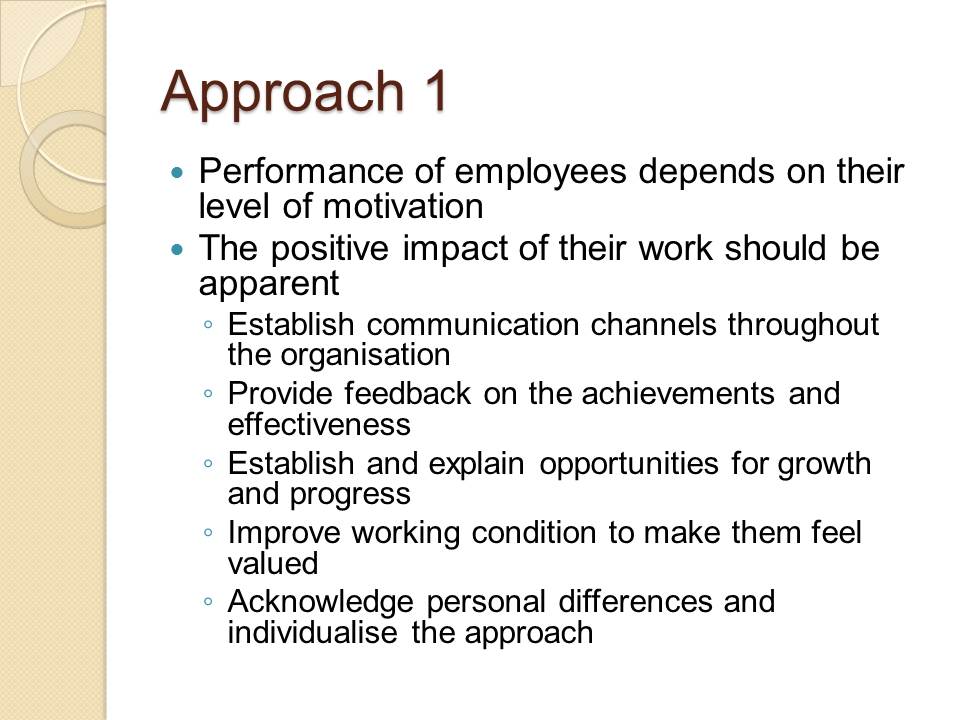
Hertzberg’s Two-factor Theory
Hertzberg’s two-factor theory (motivator-hygiene theory).
Satisfaction and dissatisfaction of employees depend on different factors.
Dissatisfaction – hygiene factors (the working environment):
- Examples: supervision, payment, security, safety.
Satisfaction – motivator factors (intrinsic to the job):
- Examples: recognition, achievement, responsibilities, engaging tasks.
Hygiene and motivation factors influence motivation independently.
The motivation theory behind the approach above is Hertzberg’s two-factor theory, also referred to as motivator-hygiene theory (Ozguner & Ozguner 2014). The main premise of the theory is the existence of two groups of factors. The first group (hygiene) includes the factors of the job context, such as safety and security, salary, and supervision, and determine the dissatisfaction level of staff. The second group (motivator factors) includes interesting tasks, perceived achievement, responsibilities, and recognition, and determines the level of motivation. These factors influence motivation independently and have to be dealt with individually.
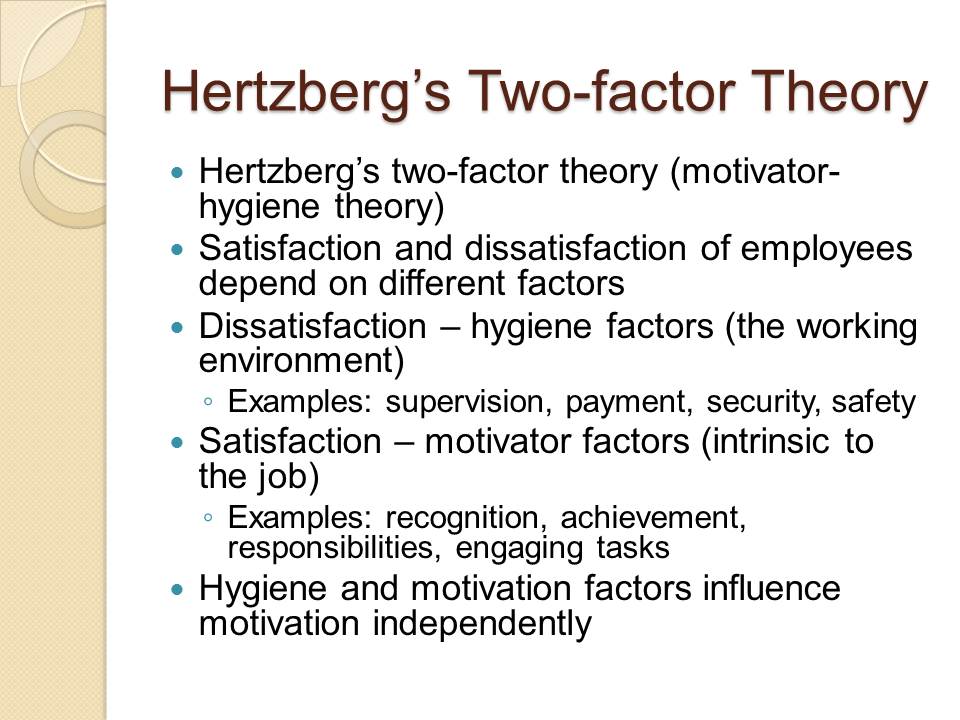
Approach 2
- Employees work harder when the impact of their actions is apparent;
- The relevance and outcomes should be made transparent;
- Goals and vision can be reflected in minor details;
- Perceived support in all aspects of life increases engagement;
- Working conditions should not interfere with private lives;
- Financial stability and security combined with recognition.
As was mentioned above, employees tend to demonstrate greater engagement when the effects of their input are visible. This visibility can be achieved in two ways: by increasing transparency of the company’s performance and by introducing minor details that would reflect the value of the job and frame it in a positive way. At the same time, it is necessary to ensure that working conditions and financial aspects of employment are sufficient for fulfilling life experience.
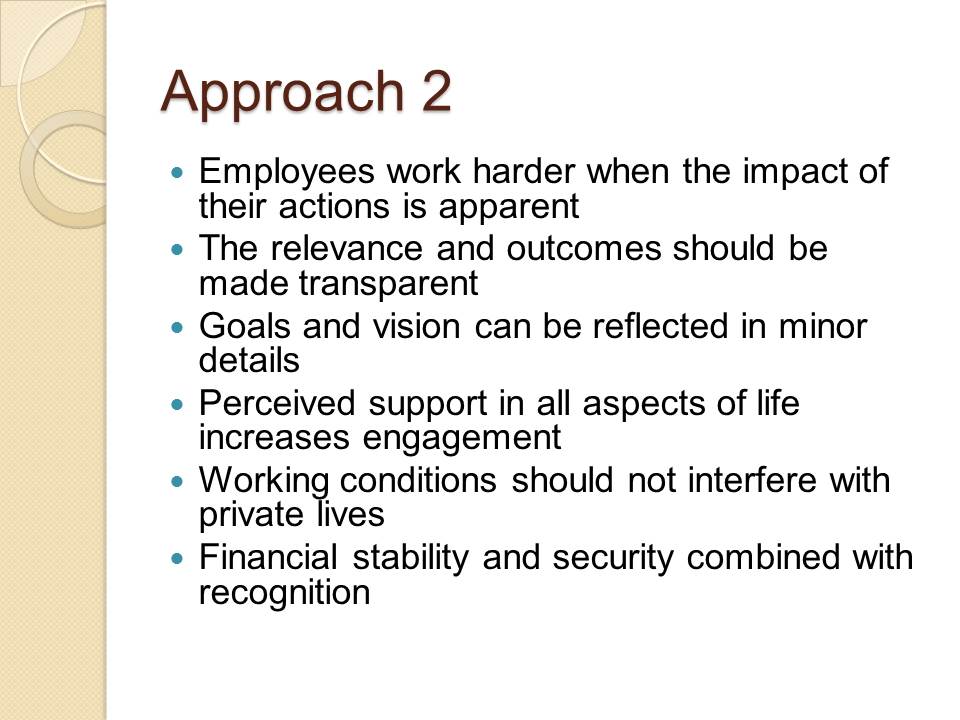
Approach 3
Reward system should include diverse options.
Tangible rewards: salary, bonuses, monetary incentives.
Intangible rewards: various desirable options:
- Physical: workplace and work-related enhancements;
- Social: ability to reward co-workers on a horizontal level;
- Organisational: paid vacations and days off;
- Developmental: training courses and workshops.
It is important to understand that direct monetary rewards create only a partial sense of fulfilment (Jerome 2013). Thus, it is necessary to diversify the system by including intangible rewards. These rewards can cover a wide range of options, including workplace-related conditions, the possibility to issue rewards to co-workers (bypassing the management’s approval), coverage of vacations and paid days off, and availability of training courses.
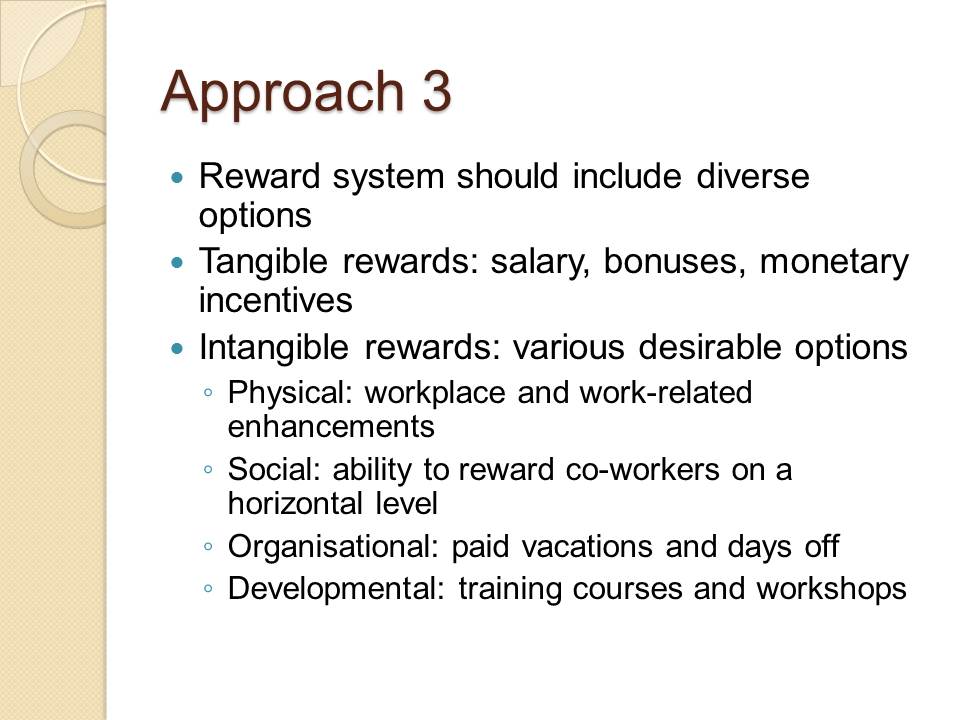
Maslow’s Hierarchy of Needs
Maslow’s Hierarchy of Needs: five levels:
- Physiological – most basic needs dictated by the need to survive;
- Safety – personal and financial security;
- Social – need for social interactions and fulfilling relationships;
- Esteem – need for recognition from peers;
- Self-actualisation – need to achieve full potential.
Needs are to be achieved in hierarchical sequence.
The approach is consistent with Maslow’s Hierarchy of needs theory. According to it, the ability to maximise performance is intrinsic to humans. However, reaching this stage is only possible when other levels of needs are satisfied. These include physiological needs (e.g. water, nutrition, and housing), safety (financial security and health), social (the need for meaningful interactions and relationships), and esteem (sense of confidence and recognition) (Kaur 2013). According to the theory, reaching maximum potential is possible only after all prerequisites are met.
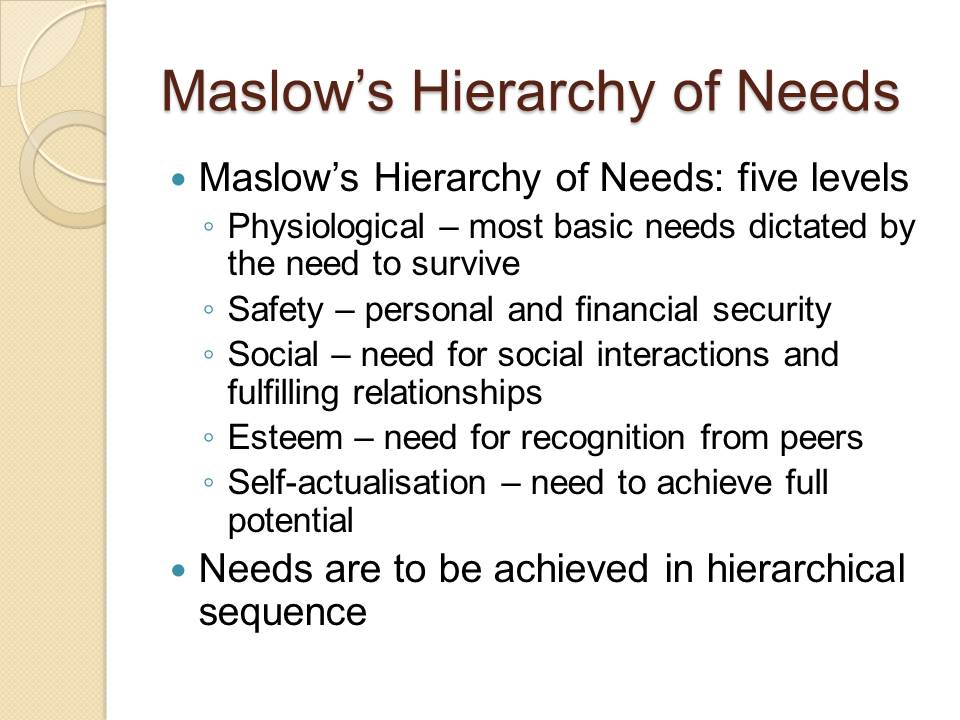
Approach 4
- Realistic outcomes are crucial for employee motivation;
- Can be formulated as milestones or expectations;
- Unrealistic expectations discourage decision-making;
- Setting achievable goals strengthens employee’s esteem;
- Workers feel empowered and obtain a sense of direction;
- Establish a reward system and specify outcomes.
Another way of increasing employee motivation and facilitating leadership in the workplace is by setting realistic and clear goals. Excelling at certain tasks usually requires high standards of quality, which prompts some managers to raise the bar unreasonably high. As a result, employees feel discouraged to accept responsibilities and make decisions. Instead, it is recommended to specify achievable goals and connect them to expected rewards and incentives.
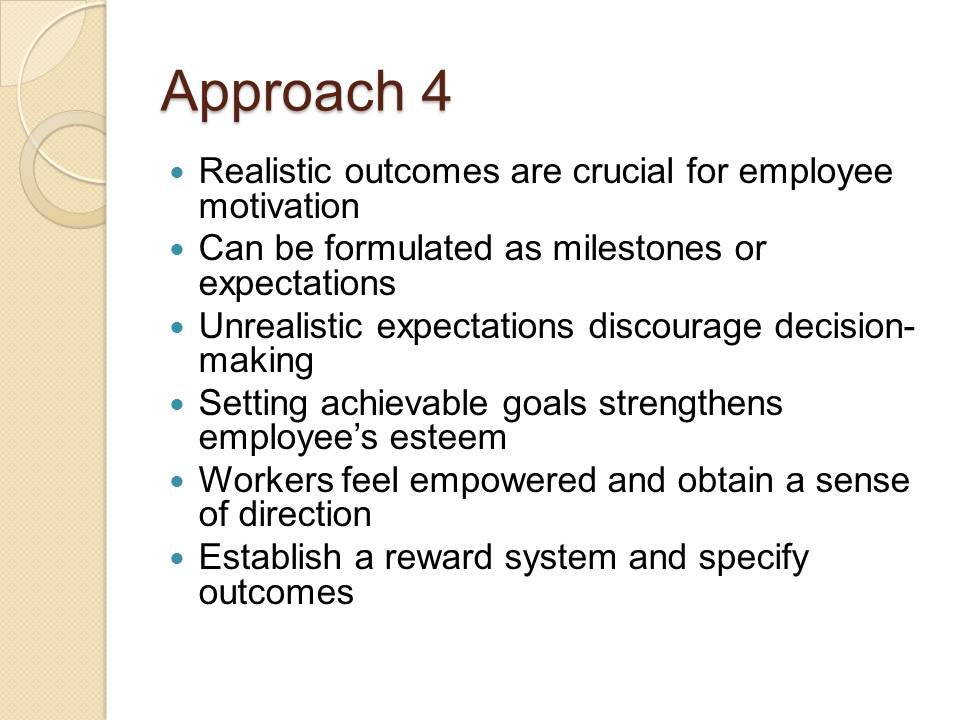
Approach 5
Connecting objectives to goals is essential for motivation.
Setting performance standard is insufficient.
Employees approach the task in three steps:
- Is the new standard achievable?
- What outcomes can be expected as a result of success?
- Are the expected outcomes desirable?
In order for these incentives to be effective, they must be doable and relevant for the employees (Agadoni n.d.). Thus, the motivation behind each action is determined through a three-step approach – determining whether the new objective is realistic, outlining the outcomes of success, and checking whether the new outcomes are desirable. The tasks that satisfy all three of these criteria have much higher chance of reaching the desired level of engagement and leadership. Therefore, these criteria should be used as a framework for the management as a way to facilitate the necessary level of motivation.
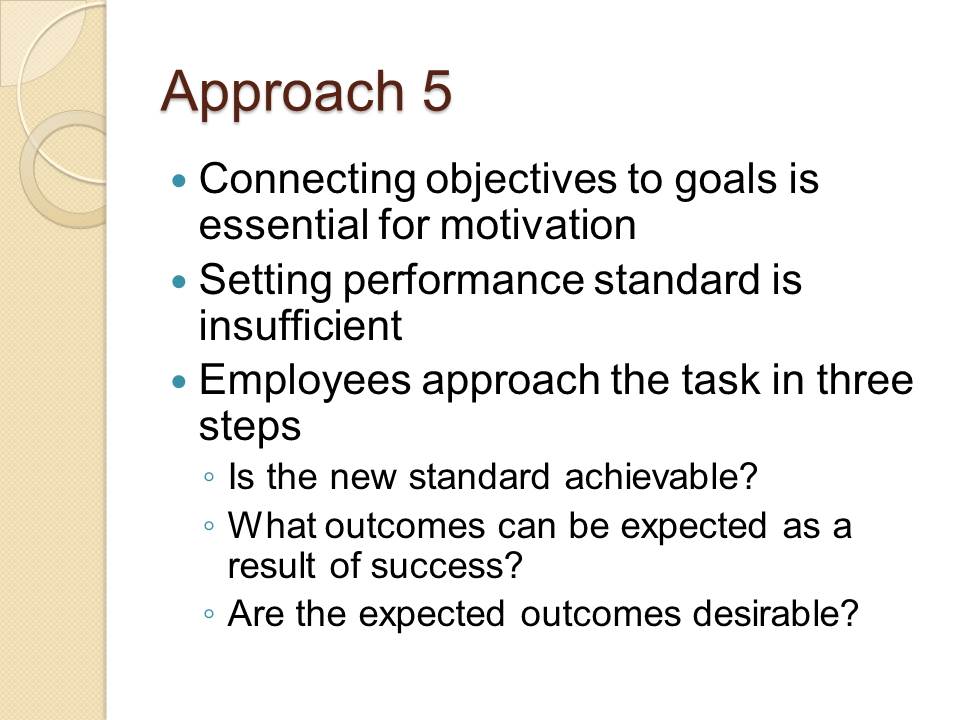
Vroom’s Expectancy Theory
Vroom’s Expectancy Theory – three key factors:
- Expectancy: perceived connection between effort and reward;
- Instrumentality: degree of certainty behind the expectation;
- Valence: value of the expected rewards for employee.
Motivation is dictated by the relevance outcomes.
Based on rational calculation and experience.
Level of engagement depends on outcome’s likelihood.
The approach described above is consistent with the principles of the expectancy theory. According to the theory, employee behaviour is determined by the expectation of respective rewards. In other words, the expected reward is the main determinant of workplace performance. This connection is established based on previous experience and is known as expectancy. The degree of certainty behind the expectation is termed instrumentality. Finally, the relevance of the reward to employees is known as valence (IFM n.d.).
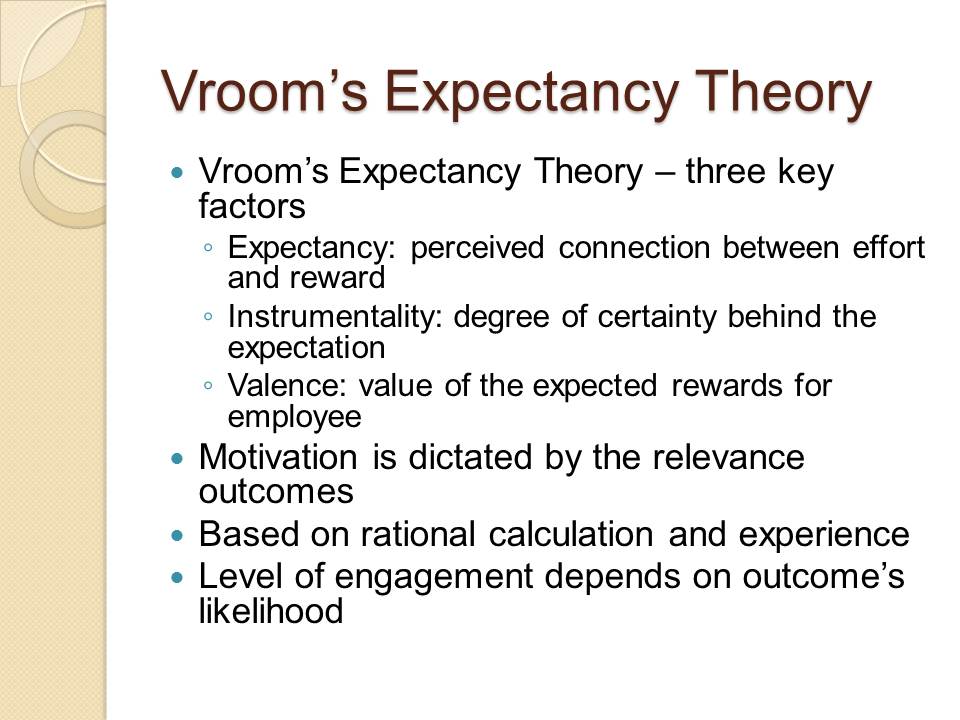
Reference List
Agadoni, L n.d., Expectancy theory in business organizations, Web.
IFM n.d., Vroom’s expectancy theory, Web.
Jerome, N 2013, ‘Application of the Maslow’s hierarchy of need theory; impacts and implications on organizational culture, human resource and employee’s performance’, International Journal of Business and Management Invention, vol. 2, no. 3, pp. 39-45.
Kaur, A 2013, ‘Maslow’s need hierarchy theory: applications and criticisms’, Global Journal of Management and Business Studies, vol. 3, no. 10, pp. 1061-1064.
Ozguner, Z & Ozguner, M 2014, ‘A managerial point of view on the relationship between of Maslow’s hierarchy of needs and Herzberg’s dual factor theory’, International Journal of Business and Social Science, vol. 5, no. 7, pp. 207-215.
Yusoff, WFW, Kian, TS & Idris, MTM 2013, ‘Herzberg’s two factors theory on work motivation: does its work for todays environment’, Global Journal of Commerce and Management, vol. 2, no. 5, pp. 18-22.